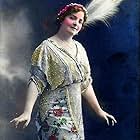As a silent film enthusiast, I am constantly amazed at the rediscovery of old movies long thought to be lost. Many were discovered in archives in Russia and Eastern Europe after the fall of the Soviet Union. However, occasionally, some turn up in unexpected places like THE PASSION OF JOAN OF ARC in a closet in a Norwegian asylum or a Mary Pickford film in a barn in New England. THE UNDESIRABLE was recently located in the basement of a Hungarian culture center in New York and returned to Hungary for restoration. The movie is a major find as it gives us the opportunity to view an early work from his native country of one of Hollywood's legendary directors .
Mikhaly Kertesz (who would become Michael Curtiz in America and later direct CASABLANCA) made this 1915 adaptation of a then well known Hungarian play. While the scenario is a pretty standard affair of a servant falsely accused of theft, the film is a remarkable historical document of turn of the 20th century Hungary. The peasant costumes worn by all the characters are visually striking and absolutely authentic (because they're the real deal) while the use of outdoor locations are like picture postcards. Although there is no camera movement in a film of this vintage, Curtiz's camera setups are direct and effective and show an early eye for how to compose a shot.
The performances are a little broad at times but then the characters are meant to be country folk. The actors occasionally step out and gesture directly to the camera (like an aside on stage) but that was normal for European silent cinema at this time. The story concerns a young village girl who goes to the city and finds employment as a maid. After being falsely accused of theft (making her THE UNDESIRABLE of the title), she is forced to go back to her village where her mother, whom she thought dead, has returned after being in jail for murdering her abusive husband. There is a reunion and a highly unexpected twist before the happy ending.
The restoration which took almost a year is absolutely stunning and the film looks gorgeous though I question the use of some of the color tints employed . Why are the city living room scenes gold for example or the return trip to the village green? Also some of the title cards are translated as if in peasant dialect "I am a honest girl" or "she tried to flirt me". The title cards are also "leaders" telling us what is going to happen rather than what is happening. The newly commissioned score by Attila Pacsay is wonderfully atmospheric and idiomatic especially during the wedding finale. Another excellent silent offering from Olive Films. More please!..For more reviews visit The Capsule Critic.






















